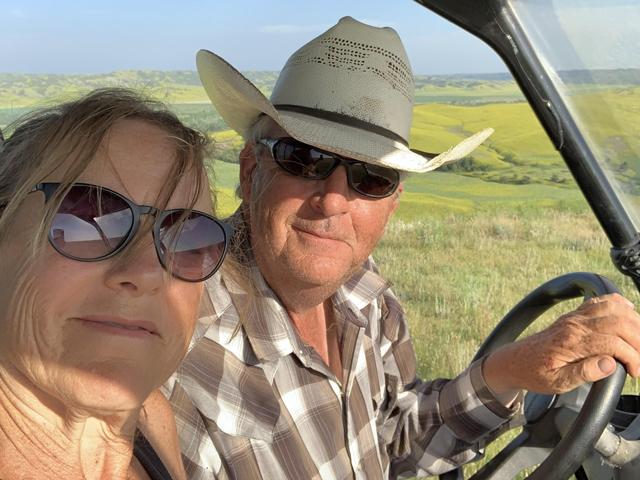Carbon and Cows
Carbon Credits Add Income Stream for Family Ranch
Successfully diversifying ranch income is a long game at best, and it's always challenging regardless of the cattle market. But for producers who see their commodity as more grass than beef, conserving native forages and building carbon in the soil may be a natural fit in today's carbon markets.
Fourth-generation South Dakota rancher Todd Trask decided he'd roll the dice on the carbon idea. He thought it might be a good fit, especially since his production philosophy is inherently conservationist in tone. He still manages to feed some 600 mama cows, but he does it with a take-half, leave-half approach that goes back generations in this part of the world.
Today Trask is in his second year of a 10-year carbon credit contract with Agoro Carbon Alliance. He's pleased with how the program is working and says it's a way to increase revenue so the ranch can support his kids being a part of the family business.
"This is really a family operation," Trask told DTN of the ranch near Wasta. "I run this place with my wife, Samra; my son, Tyler; son-in-law, Evan Anderson; and my daughter, Jaymie Anderson. We don't farm any here, we pretty much just run the business on grass, and we try to do that year-round. We do put up some hay, but grass is our main commodity."
The cow-calf operation is registered Angus, with a stocking rate of one cow to 25 or 30 acres of grass. Grasses are all native forages like buffalo grass, western wheatgrass, and sideoats grama.
Trask signed his 10-year contract with Agoro in December 2021, after multiple meetings with their soil scientists to be sure both he and they wanted the same things from the partnership.
"I wanted to be really clear on what their expectations were, because this was so new for us," said Trask. "It was very important that we understood completely the situation and knew what we were agreeing to."
Trask said he had his attorney look at the contract, and there were no deal-breakers. He also worked closely with Agoro soil scientist Brekke Munks.
P[L1] D[0x0] M[300x250] OOP[F] ADUNIT[] T[]
While the contract Trask signed was 10 years in length, the rancher explained that at five years, he can opt out. In year one of the agreement, Agoro had a third party measure carbon levels to get baseline readings, and at year five, this will happen again.
"If in year five the amount of carbon (sequestered) is more than they projected to be there, then our compensation level will be raised," Trask told DTN. "If it is less than projected, our compensation level will be decreased.
"But if for some reason we want to opt out of the contract at that five-year point, we can do that. So, it's a five-year commitment for sure. At this point, I can't foresee that I would not want to fulfill the whole 10-year contract. So far everything has been exactly as it was described to me, no second-guessing on my part. I'm glad we did this."
Trask said they receive annual payments. Asked if the amount he receives is based on some type of carbon market, or baseline, he said it isn't.
"That was one of our questions going in," he said. "It's so new there are no carbon market exchanges really. There are just now other companies starting to do what Agoro is doing, and there might be a larger market moving forward."
At the beginning of the process, Trask said he could have put any or all of his operation into the carbon contract. He opted to put all the acres he could into it -- in other words, the whole place. It was an easy decision because what Agoro wanted in terms of grass management was pretty much what Trask said he was already doing.
"I really didn't have to change what we were doing," he said. "We use a take-half and leave-half philosophy of grazing. That's always been our philosophy here. That's how ranches in this part of the world were built. It's a management style that fits like a glove with what Agoro wants to do."
Asked if he would ever have to pay Agoro back any money if for some reason he did not produce an adequate amount of carbon over the term of the contract, Trask said absolutely not.
"There would never be a time I'd have to pay Agoro money back," he explained. "My payment might be reduced after year five to offset some deficit in carbon that they thought would be there and wasn't. But their soil scientists looked at everything and did soil maps and calculations upfront. They don't want to be wrong. And I don't want to be wrong. A lot went into this at the outset to determine how much carbon we will produce if the ground is properly managed."
AGORO PAYS MORE THAN $15 MILLION IN FIRST TWO YEARS
Agoro Carbon Alliance recently announced it had made more than $15 million in payments to farmers and ranchers since the company began about two years ago. Over the course of 10 years, Agoro estimates 5 million tons of carbon will have been sequestered. The company is backed by Yara International.
Agoro's interim CEO Elliot Formal said the company is committed to working hand-in-hand with farmers and ranchers every step of the way along their carbon journey, providing agronomic support that will result in more sustainable businesses and improving bottom lines.
"Our program is committed to generating the highest-quality soil carbon credits in the market through our robust scientific expertise and collaborations with leading universities," said Formal.
Farmers and ranchers interested in calculating carbon earning potential on row crop or rangeland can use the Agoro calculator here: www.AgoroCarbonAlliance.com/calculate-your-carbon-potential.
Victoria Myers can be reached at vicki.myers@dtn.com
Follow her on Twitter @myersPF
(c) Copyright 2023 DTN, LLC. All rights reserved.






